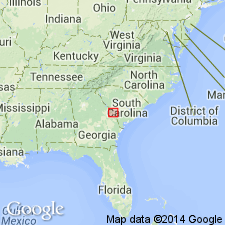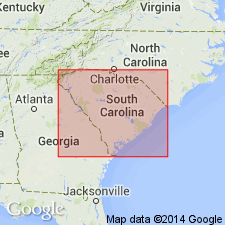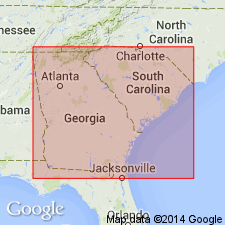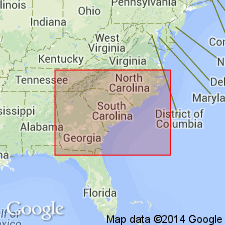
- Usage in publication:
-
- Snapp Formation
- Modifications:
-
- Named
- Dominant lithology:
-
- Sand
- Clay
- AAPG geologic province:
-
- Atlantic Coast basin
Summary:
Snapp Formation is named in southern Barnwell Co., SC. At the type section, unit is composed of 60 ft of quartz sand and interbedded kaolinitic clay. Sediments are light gray, tan, orange, and yellow, silty, micaceous, medium to coarse grained. Also contains some dark, micaceous, lignitic sands. Clays are oxidized in some places, but dark in others. Well developed in the southeastern part of the Savannah River Site, but pinches out updip near Upper Three Runs. Strata previously referred to Williamsburg Formation, but lithology is not similar to that of the type Williamsburg in eastern SC. Corresponds roughly to part of the Black Mingo Formation as used by Logan and Euler (1989). Unconformably overlies the upper Paleocene Lang Syne Formation and unconformably underlies the lower Eocene Fourmile Formation (new). Probably represents zone NP 9 (middle Sabinian, late Paleocene), based on a few palynological assemblages and well-dated strata above and below. Correlates with the Tuscahoma Sand of the Gulf Coastal Plain. Probably upper delta plain deposit.
Source: GNU records (USGS DDS-6; Reston GNULEX).

- Usage in publication:
-
- "Snapp beds"
- Modifications:
-
- First used
- Dominant lithology:
-
- Sand
- Clay
- AAPG geologic province:
-
- Atlantic Coast basin
Summary:
Unconformably(?) overlying the dark sediments of the Ellenton Formation in the downdip part of the Savannah River Site, are about 60 ft of very micaceous, very poorly sorted, silty sands and interbedded light-colored clays here informally designated the "Snapp beds." Unit appears to pinch out near the center of the Site. Unit is not well dated. It may be late Paleocene, correlating with part of the Williamsburg Formation, or it may be early Eocene and equivalent to the "unnamed unit" of Harris and Zullo, this volume.
Source: GNU records (USGS DDS-6; Reston GNULEX).

- Usage in publication:
-
- Snapp beds*
- Modifications:
-
- Overview
- AAPG geologic province:
-
- Atlantic Coast basin
Summary:
Two lower Eocene depositional sequences are recognized in the Savannah River area. The lower sequence is represented by the Snapp beds and was previously referred to the Williamsburg Formation by Harris and Zullo (1988). Upper sequence is correlated with the Fishburne Formation. Depositional sequence represented by the Snapp beds consists of basal medium to coarse, micaceous, kaolinitic quartz sand and upper white to gray to red kaolin. Interbeds of white quartz sand occur a some localities in the upper kaolin. Sequence reaches a maximum thickness of almost 17 m in the central part of the Savannah River Site and thins rapidly to the west and northwest. Probably represents a fluvial depositional environment. Authors suggest that the Paleocene dinoflagellates found in this sequence were reworked from an older unit, and they tentatively assign this sequence to the early Eocene.
Source: GNU records (USGS DDS-6; Reston GNULEX).

- Usage in publication:
-
- Snapp Formation
- Modifications:
-
- Principal reference
- AAPG geologic province:
-
- Atlantic Coast basin
Summary:
Snapp Formation is here formally proposed. Definition is identical to that of Fallaw and Price (1992), the first naming paper. The name of the overlying unit is changed in this report to Fourmile Branch Formation. To the northeast and southeast, the Snapp probably grades into siliciclastics and limestone of the upper part of the Williamsburg Formation in eastern SC. The boundary between the two formations is arbitrarily placed where the section is 5 percent calcium carbonate. To the southeast, unit grades into the Tuscahoma Sand of western GA. That boundary is placed where the silts and clays become mostly carbonaceous rather than oxidized.
Source: GNU records (USGS DDS-6; Reston GNULEX).
For more information, please contact Nancy Stamm, Geologic Names Committee Secretary.
Asterisk (*) indicates published by U.S. Geological Survey authors.
"No current usage" (†) implies that a name has been abandoned or has fallen into disuse. Former usage and, if known, replacement name given in parentheses ( ).
Slash (/) indicates name conflicts with nomenclatural guidelines (CSN, 1933; ACSN, 1961, 1970; NACSN, 1983, 2005, 2021). May be explained within brackets ([ ]).

